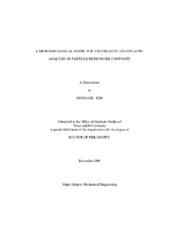| dc.contributor.advisor | Muliana, Anastasia | |
| dc.creator | Kim, Jeong Sik | |
| dc.date.accessioned | 2011-02-22T22:23:49Z | |
| dc.date.accessioned | 2011-02-22T23:45:58Z | |
| dc.date.available | 2011-02-22T22:23:49Z | |
| dc.date.available | 2011-02-22T23:45:58Z | |
| dc.date.created | 2009-12 | |
| dc.date.issued | 2011-02-22 | |
| dc.date.submitted | December 2009 | |
| dc.identifier.uri | https://hdl.handle.net/1969.1/ETD-TAMU-2009-12-7348 | |
| dc.description.abstract | This study introduces a time-dependent micromechanical model for a
viscoelastic-viscoplastic analysis of particle-reinforced composite and hybrid composite.
The studied particle-reinforced composite consists of solid spherical particle and
polymer matrix as constituents. Polymer constituent exhibits time-dependent or inelastic
responses, while particle constituent is linear elastic. Schapery's viscoelastic integral
model is additively combined with a viscoplastic constitutive model. Two viscoplastic
models are considered: Perzyna's model and Valanis's endochronic model. A unit-cell
model with four particle and polymer sub-cells is generated to obtain homogenized
responses of the particle-reinforced composites. A time-integration algorithm is
formulated for solving the time-dependent and inelastic constitutive model for the
isotropic polymers and nested to the unit-cell model of the particle composites.
Available micromechanical models and experimental data in the literature are used to
verify the proposed micromechanical model in predicting effective viscoelasticviscoplastic
responses of particle-reinforced composites. Filler particles are added to enhance properties of the matrix in the fiber reinforced polymer (FRP) composites. The
combined fiber and particle reinforced matrix forms a hybrid composite. The proposed
micromechanical model of particle-reinforced composites is used to provide
homogenized properties of the matrix systems, having filler particles, in the hybrid
composites. Three-dimensional (3D) finite element (FE) models of composite's
microstructures are generated for two hybrid systems having unidirectional long fiber
and short fiber embedded in cubic matrix. The micromechanical model is implemented
at the material (Gaussian) points of the matrix elements in the 3D FE models. The
integrated micromechanical-FE framework is used to examine time-dependent and
inelastic behaviors of the hybrid composites. | en |
| dc.format.mimetype | application/pdf | |
| dc.language.iso | en_US | |
| dc.subject | viscoplasticity | en |
| dc.subject | micromechanics | en |
| dc.subject | homogenization | en |
| dc.subject | hybrid composite | en |
| dc.subject | particle | en |
| dc.subject | viscoelasticity | en |
| dc.title | A Micromechanical Model for Viscoelastic-Viscoplastic Analysis of Particle Reinforced Composite | en |
| dc.type | Book | en |
| dc.type | Thesis | en |
| thesis.degree.department | Mechanical Engineering | en |
| thesis.degree.discipline | Mechanical Engineering | en |
| thesis.degree.grantor | Texas A&M University | en |
| thesis.degree.name | Doctor of Philosophy | en |
| thesis.degree.level | Doctoral | en |
| dc.contributor.committeeMember | Ochoa, Ozden | |
| dc.contributor.committeeMember | Gao, Xin-Lin | |
| dc.contributor.committeeMember | Benzerga, Amine | |
| dc.type.genre | Electronic Dissertation | en |
| dc.type.material | text | en |


